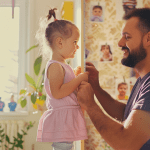Common Household Accidents
So, what kinds of accidents might we face in our daily lives? Here are some shocking statistics that every parent should consider:
- Fire and Burns: Kitchens and barbecues are hotspots for potential danger.
- Suffocation: A tragic risk that can occur with bedding items or plastic bags present.
- Drowning: Water poses significant risks, be it in bathtubs, swimming pools, or hot tubs.
- Choking: Certain foods, toys, and even household items can present choking hazards.
- Poisoning: Common household products might be lurking in cabinets or purses, posing threats.
- Falls: Stairs, slippery surfaces, and poorly anchored furniture spell disaster waiting to happen.
Preventing Accidents
The essence of protecting your little ones lies in being vigilant. Here’s what you can do:
- Be Present: Always supervise young children, as they are quick to explore, whether it’s a hot stove or a steep staircase.
- Emergency Preparedness: Equip yourself by learning CPR and mastering age-appropriate first-aid techniques.
- Emergency Contacts: Place critical numbers near your phone, including:
- Poison Control: 1-800-222-1222
- Your doctor’s contact info and nearby relatives.
- First-Aid Kit: Assemble a comprehensive kit and include essential emergency instructions.
- Safety Devices: Ensure that smoke detectors and carbon monoxide detectors are installed and maintain fresh batteries!
The heart of childproofing is more than just physical barriers—it’s about creating a safe environment where children can explore and learn without unnecessary risks. By taking proactive steps, you can turn your home into a haven for your budding explorers. Remember, while accidents can happen in the blink of an eye, your preparation can help you react effectively if they do.
Childproofing and Preventing Household Accidents
If you’ve never crawled around your home on your hands and knees, give it a go. This simple activity can provide invaluable insights into the household hazards that young children may encounter, allowing you to view your home from their perspective and make necessary adjustments for safety. Kids explore their everyday settings, and this will let you see things as they do to make sure your home is safe.
Understanding the Risks
When we think of “baby-proofing” or “childproofing,” we often focus on infants and toddlers. And while it’s true that these young children are at the highest risk for injuries, it’s essential to recognise that accidental injury is the leading cause of death for children up to 14 years old. Astonishingly, more than a third of these injuries occur at home, a space that should ideally be a haven of safety.
Common Household Accidents
Understanding the kinds of accidents that can occur at home is crucial for effective prevention. Some common causes of home-injury deaths include:
- Fire and Burns: Occur primarily in kitchens, especially during cooking or while using heating devices.
- Suffocation: Often caused by soft bedding, toys, or even plastic bags.
- Drowning: Risks are prevalent in bathtubs, swimming pools, or any area with standing water.
- Choking: Commonly involves foods that pose choking risks, such as grapes, hot dogs, and small toys.
- Falls: Hazards include stairs, slippery floors, and unsteady furniture that may tip over.
- Poisoning: Often involves toxic substances stored under sinks or in medicine cabinets.
- Firearms: Access to unsecured firearms increases risk significantly.
Common Hazard Areas in the Home
Most household accidents occur in specific areas, such as:
- Water: Bathrooms, kitchens, swimming pools, or hot tubs can pose drowning risks.
- Heat or Flames: Kitchens or near barbecues can lead to burns or scalds.
- Toxic Substances: Household cleaners, medications, and other harmful substances that might be stored under sinks or in garages should be kept out of reach.
- Potential for Falls: Stairs, slippery floors, and windows pose significant risks for injury.
- Choking Hazards: Items that could entrapped or strangle a child are common dangers, particularly small toys or household items.
Preventing Accidents
The primary safeguard is vigilant supervision of young children. No matter how childproof your home may seem, it only takes a moment for a child to reach for something dangerous. Thus, the best approach is to combine prevention strategies with close monitoring. Here are several effective ways to make your home safer:
1. Learn Life-Saving Skills
It’s beneficial to be prepared in case of emergencies:
- Learn cardiopulmonary resuscitation (CPR) techniques suitable for different ages.
- Become proficient in the Heimlich maneuver for different age groups.
2. Emergency Contact Information
Make it a habit to keep essential contact numbers close to your phone. These should include:
- Poison Control: 1-800-222-1222 (also available online)
- Your child’s doctor
- Parents’ work and cell phone numbers
- A neighbour’s or nearby relative’s contact information for quick assistance
3. Create a First-Aid Kit
Having a well-stocked first-aid kit is essential. Ensure it contains:
- Adhesive bandages of various sizes
- Antiseptic wipes
- Gauze and tape
- Scissors
- Emergency contact numbers
4. Install Safety Devices
Install smoke and carbon monoxide detectors in strategic locations throughout your home. Make sure to change the batteries regularly and test the alarms monthly to ensure they’re functioning properly.
Conclusion
Childproofing your home is an essential step in keeping your children safe from potential accidents and injuries. By understanding common hazards, maintaining vigilance, and preparing for emergencies, you can create a safer environment for your little ones. Every corner of your home can be a learning space for your children; with proper preventive measures in place, you can rest assured that their explorations are as safe as possible. Encourage curiosity, but always be ready to spring into action to protect your child’s health and safety. Together, let’s work towards a safer home! Your child’s safety is a priority—start childproofing today!

| Key Points | Details |
|---|---|
| Importance of Childproofing | Childproofing is essential as accidental injuries are the leading cause of death in children up to 14 years old. |
| Common Household Accidents | Household accidents can involve fire, suffocation, drowning, choking, falls, poisoning, and guns, often occurring in specific home areas. |
| Areas of Risk | Common risk areas include bathrooms, kitchens, swimming pools, around heat sources, and places with toxic substances or fall hazards. |
| Preventive Measures | Active supervision of young children is crucial, along with preparedness for accidents through training and having emergency contacts readily available. |
| Emergency Preparedness | Learning CPR, having a first-aid kit, and installing smoke and carbon monoxide detectors are key steps to prevent serious accidents. |



